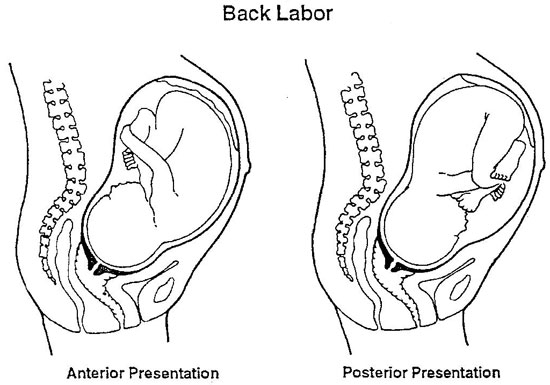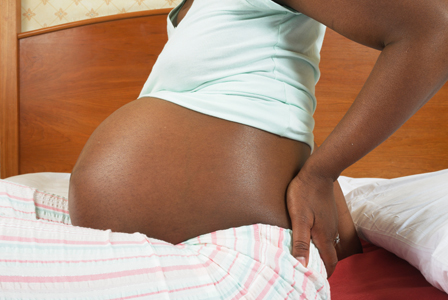One of the most physically challenging and demanding events in a woman's life is labor. To prepare for this pinnacle moment, many women exercise, eat healthy and educate themselves on the labor experience. They learn there are many types of labor including "back labor." It's a common occurrence that brings with it extreme discomfort.
 Back labor is often caused by the position of your baby. When the baby is facing the mother's abdomen, his head is pushing on her tailbone which sometimes causes lower back pain. However, the position of the baby does not always cause this discomfort. Studies have suggested that women who have back labor often experience back pain during their monthly menstrual cycle as well.
Back labor is often caused by the position of your baby. When the baby is facing the mother's abdomen, his head is pushing on her tailbone which sometimes causes lower back pain. However, the position of the baby does not always cause this discomfort. Studies have suggested that women who have back labor often experience back pain during their monthly menstrual cycle as well.
What Does Back Labor Feel Like?
 It is referred to as back labor because of the discomfort and pain a women experiences in the lower part of their back. Most women will feel some kind of soreness in this area during labor, but approximately 25% will experience extreme discomfort in their lower back. This pain will be present most of the labor, with it being the worst during contractions. Often a woman experiencing back labor will have prolonged pushing, a long labor and irregular contractions.
It is referred to as back labor because of the discomfort and pain a women experiences in the lower part of their back. Most women will feel some kind of soreness in this area during labor, but approximately 25% will experience extreme discomfort in their lower back. This pain will be present most of the labor, with it being the worst during contractions. Often a woman experiencing back labor will have prolonged pushing, a long labor and irregular contractions.
What Moms Say About This
“It was one of the most painful experiences of my life. It felt as if someone was pulling my back in several different directions. The pain radiated from everywhere. It took extra medication after the delivery to help with the pain in my tailbone area. If you can have your husband push on your back's pressure points during labor, it helps a lot.” -- Shannon
“My delivery was all back labor when my daughter was born. She was face up and the pain radiated from my tailbone all the up to my back. It felt like someone was pulling my back apart, pulling from the top and bottom. I couldn't lie on my side because the pain was worse when I did. It was actually more comfortable laying on my back and putting pressure on it.” -- Melanie
“My labor pains shot straight up from my pelvic area and into my back. It kind of radiated around my whole lower back area. Even though I tried to change positions, I could not find any relief. I was already experiencing back pain during my pregnancy, so it was just more intensified." -- Maggie
"All I had was back labor! It was so bad; it traveled from my back to my sides and even into my abdomen area. It sort of felt like the cramps you get before your period but many times worse. I had irregular contractions with my daughter's birth, but my back hurt constantly. The doctor who answered my after-hours call had a lot of experience and told me to rush to the hospital. Thank goodness we listened to him. She was born only a few hours later!" -- Patty
"So you ask "what does back labor feel like?" My back labor was so horrible. I could barely walk for a few days afterwards. My tailbone was so sore! I never had pain in my abdomen, just my tailbone and lower back. It felt like someone was hitting me with a hammer every time I had a contraction. It hurt so bad!" -- Laura
Can It Cause Harm to My Baby or Me?
It's not the back labor that is the issue but the position your baby may be in. It may be harder for you to deliver your little one because it may be difficult for him to go down the birth canal. This may make your labor longer, more painful and may even cause your doctor to deliver your baby via a C-section.
How Can Back Labor Be Relived?
Now that you have an idea about "what does back labor feel like?" you may be wondering what can be done to relieve the pain. Here're some ways that may help.
1. Massage
Your birthing coach, spouse or whoever may be near can assist you. One technique that seems to work is applying pressure with a balled up fist to your lower back. Your partner can also try using a soft ball like a tennis ball. If you have two people that can assist you, you can try the double hip squeeze. This massage position is fairly simple. You simply lean forward while the two people put pressure on each of your hips.
2. Walking and Moving
Walking and moving around can often help ease the pain and discomfort of back labor. As long as there are not any specific concerns or restrictions, the hospital staff should let you walk around your room or the hospital floor. Also when you take a short walk, your baby may reposition itself in the womb and ease the pressure off your back.
3. Changing Positions
This can simply be accomplished by shifting from one sitting position to another. There are also several other positions you can try.
- One way is to straddle a chair and lean slightly forward. This can also be accomplished by kneeling against a birthing ball. If you lie on your side, your baby may move positions and take the stress off your back.
- Using the hands and knees position can often relieve pain associated with back labor. You are doing just what the name indicates, kneeling on the floor and then supporting yourself with your hands and knees. When you are in this position, your baby has the room to reposition himself. It also reduces pressure to your lower back and cervix, making back labor more tolerable.
4. Heat or Cold Compress
If the hospital will allow it, use a heating pad with a cord long enough to comfortably reach you on the bed. If you don't have a heating pad, use a hot compress. You can easily make your own by wetting a towel with warm water and then pressing it to the area of discomfort. If the heat is not helping, try a cold compress. You can wet a towel with cold water or use an ice pack.
5. Water
Ever wonder "what does back labor feel like in a tub full of water?" It can provide a great deal of comfort to an expectant mother. Besides promoting relaxation, it is sometimes easier to move into different positions. If you place a towel on the tub floor, you can use the hands and knees position while allowing the shower water to hit your back.
Can It Be Prevented?
You cannot predict if you will experience back labor. However, some researchers have found evidence that woman who had back labor during previous deliveries have a higher chance of going it through again. This does not mean all is lost. You can still take preventative measures that can increase the odds of your baby being in a better fetal position.
During Pregnancy
- It helps to spend time sitting on a birth ball each day.
- Relaxation techniques like massage are helpful as well.
- Exercise is important, not only for back labor but regular labor too.
- Incorporate pelvic tilts into your daily routine to relieve your aching back.
- Also, keep track of what position your baby is in when you go to the doctor for your regular checkups. This way you can communicate your concerns and discuss possible solutions.
During Labor
- Try to stay off your back. This will decrease your chances of having back labor in the first place.
- When you need to lie down, try lying on your side or in a tilted elevated upward position.
- Walk around or sit backwards on a toilet or chair. If you can handle it, sit on a birth ball.
